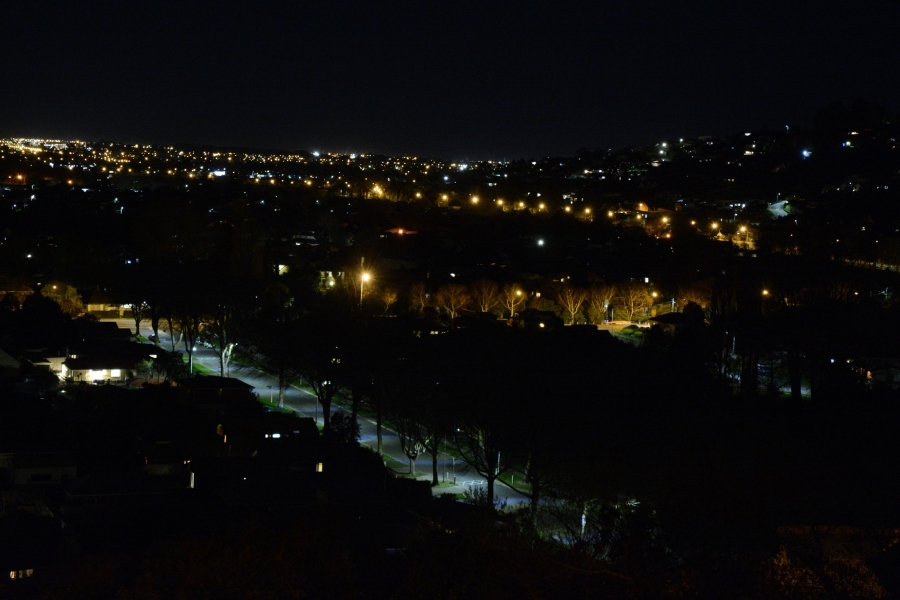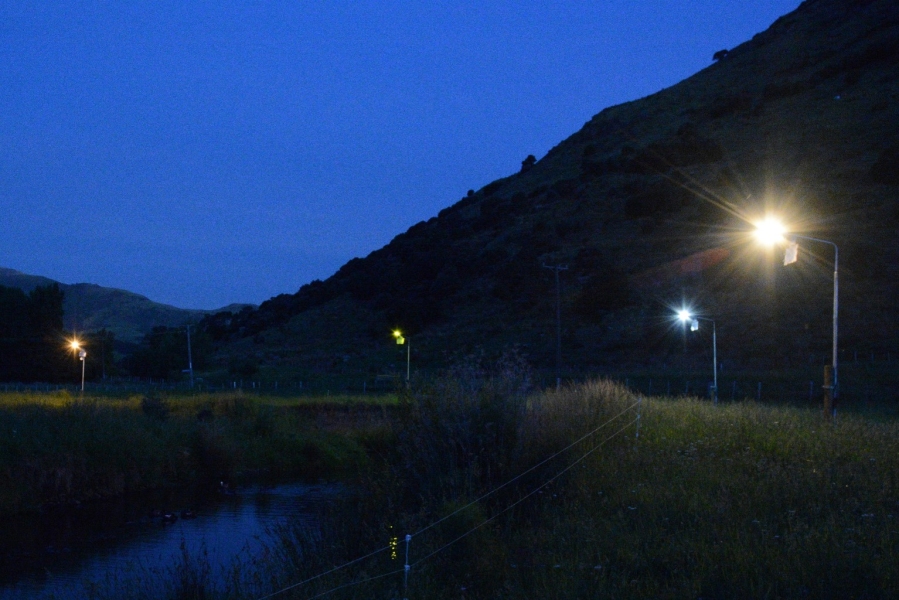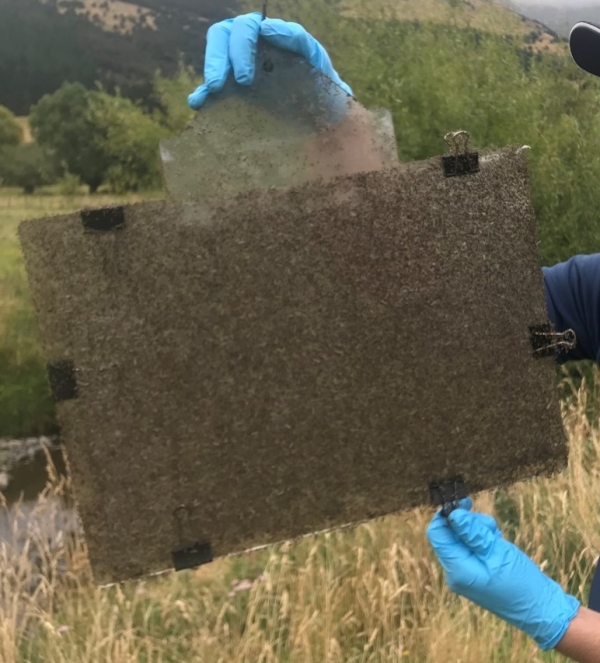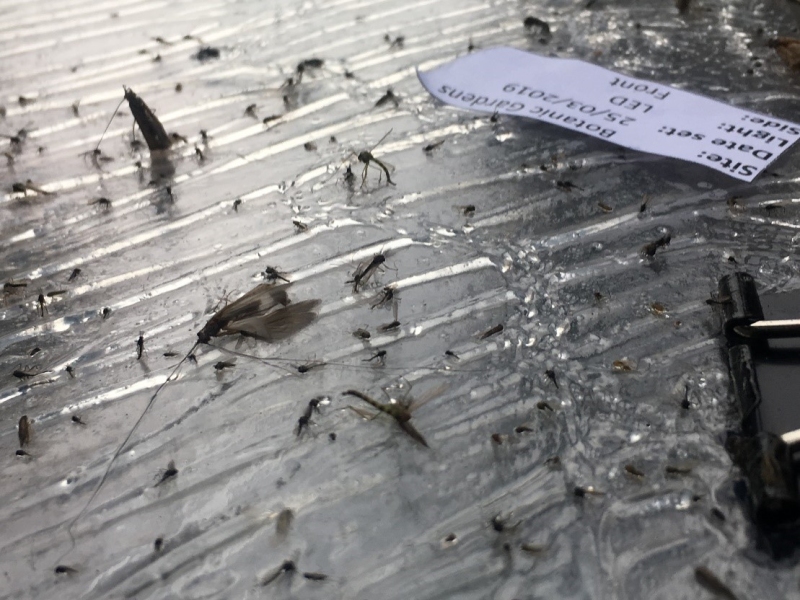Many New Zealand cities and towns have switched over to modern LED street lighting. The move will save on operational costs, but little is known what impact artificial streetlights have on flying freshwater insects which are integral to our waterway ecosystems. NIWA investigated the likely impact as part of a four-year MBIE-funded Smart Idea project.
Matching a worldwide switch to energy-efficient streetlight technology, about 370,000 streetlights across New Zealand (predominantly yellow high-pressure sodium (HPS) lamps) have recently been replaced, mainly with blue-white light-emitting diodes (LEDs).
While the economic benefits of conversion are significant (millions of dollars a year in reduced operational costs), the potential ecological impacts of the conversion to LED lighting are less certain.
Most of the currently approved blue-white LED streetlights emit a higher proportion of blue light than some (but not all) of the older streetlights. The characteristics of both the original light and the replacement LED will determine whether the amount of blue light in the urban environment will increase or not. Previous research has demonstrated that artificial light negatively affects terrestrial and aquatic ecosystems and reduces night sky visibility globally.
Blue light in particular is known to affect many organisms, including insects that live in our waterways and provide food for fish such as juvenile tuna (eels) and, once the insects emerge as flying adults, for pekapeka (bats) and birds such as piwakawaka. Urban waterways provide important ecosystem services and contribute to cultural wellbeing, but their health is declining globally. Ecological light pollution may contribute to poor ecosystem functioning in urban waterways by altering the behaviour of emerging adult aquatic insects.
We investigated the influence that the conversion of traditional streetlights to blue-white LEDs had on attraction rates of flying freshwater insects. We also adapted a method for visualising city-scale streetlighting to quantify spatial patterns in lighting across Ōtautahi (Christchurch). By mapping city “lightscapes” and investigating changes in the behaviour of adult insects under different lighting scenarios this research was aimed to provide information that could assist in the design of ecologically sensitive streetlighting plans and help identify critical areas where alternative lighting solutions might be required.
The experiments
We conducted three experiments to capture insects flying around different types of lights near waterways. The number of insects caught in sticky traps (Experiments 1 and 2, see details below) and water traps (Experiment 3) adjacent to different light types were counted each night to compare relative insect attraction. We captured more than one million insects over more than 40 nights of trapping across all experiments. The experiments were designed to answer three key questions:
- Does switching from high pressure sodium (HPS, 70 Watt) to 4000 K LED (20 Watt) streetlights increase attraction of insects to streetlights? This experiment was conducted in two locations using streetlights deployed at operational scale: a. the Ōtautahi (Christchurch) residential redzone adjacent to the Ōtakaro Awa (Avon River), which is an urban area with no house lighting, and b. in the comparatively light naïve Kaituna Valley, Banks Peninsula.
- Can we select specific LED streetlights to reduce insect attraction? In the Kaituna Valley, Banks Peninsula, we compared the number and type of insects attracted to three different types of LED streetlight (4000 K blue-white, which is in current use and 2200 K blue-white and a yellow LED).
- Do blue-white LEDs that emit more blue light attract more insects? Secondary questions included: “Are effects consistent for rivers that occur in light naïve and urban areas?”, and “At what distance from a river do lights attract flying freshwater insects?” As part of her MSc research project, Canterbury University student Jess Schofield compared attraction rates of caddisflies to 3000 K, 4000 K, 5650 K and 6000 K blue-white LEDs using smaller-scale light traps at Ōtakaro River (urban Ōtautahi) and Hawdon River (Arthurs Pass National Park). She also investigated attraction rates to lights over distances up to 100 metres from the Hawdon River.
Main research findings
- Our city-scale lightscape mapping allowed visualisation of light and dark areas across Ōtautahi (Christchurch) under different streetlighting scenarios. This tool/technique could be used to investigate intensity thresholds at which streetlights may become dispersal barriers to different taxa (i.e., do areas of high light intensity reduce natural distribution of insects, and does artificial lighting in greenspaces or along river corridors have the potential to fragment habitat?).
- The conversion from HPS streetlights to 4000 K LED generally reduced insect attraction, contrary to our initial expectations given that the LEDs emit a higher proportion of blue light than the HPS. However, it is possible that this apparent effect is dependent on the relative brightness of the two light types – at four of the five sites, the HPS had higher light output than the LEDs. At one site, where the lampposts were shorter and the light intensity of the HPS and LED lights were similar at ground level, more insects were attracted to the LED light than to the HPS light. Our results showed that light intensity and the colour spectrum perceived by the focal taxa both influence attraction rates.
- Caddisfly taxa were attracted to blue-white LEDs that emitted more blue light. This effect was largely consistent across different caddisfly taxa, and adjacent to rivers in light naïve areas (Arthurs Pass National Park), or better lit urban areas. Although caddisflies were attracted to lights up to 100 metres from a river, a high proportion of individuals were captured within 20 metres from the river.
- Operational scale streetlight experiments showed that many but not all, insect taxa were more attracted to the LEDs that emitted more blue light than blue-white LEDs with a lower colour temperature, or to those that emitted no blue light (yellow LED).
Conclusion
Overall, we concluded that using lights that emit less blue light is likely to benefit certain groups of insects (particularly moths and caddisflies), with the magnitude of effect depending on the relative light intensity and colour spectrum of the lamps being replaced, and on the focal taxa. Placing lights further from waterways or behind screens such as riparian plants, where possible, will also likely reduce the attraction of freshwater insect to streetlights.
Collaborators:
- NIWA staff: Dr Kristy Hogsden, Dr Amy Whitehead, Brian Smith
- Dr Jon Bennie, University of Exeter
- Dr Steve Pawson, University of Canterbury
- Jessica Schofield
- Project set up advice: Julian Chisnall and Carol Bannock; Waka Kotahi NZ Transport Agency, Geoff English and Andrew Cameron; CCC.
- Installation of luminaires in redzone: Connectics
- Supply of luminaires: Allan Stephenson, Signify, Connectics
- Technical assistance: Amber Sinton, Oonagh Daly, Brendon Smith, Alex Rose, Paul Lambert – NIWA, Emily Carr.





